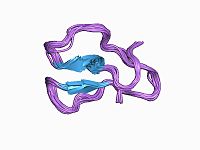
Photo from wikipedia
Chitin-binding lectins form the hevein family in plants, which are defined by the presence of single or multiple structurally conserved GlcNAc (N-acetylglucosamine)-binding domains. Although they have been used as probes… Click to show full abstract
Chitin-binding lectins form the hevein family in plants, which are defined by the presence of single or multiple structurally conserved GlcNAc (N-acetylglucosamine)-binding domains. Although they have been used as probes for chito-oligosaccharides, their detailed specificities remain to be investigated. In this study, we analyzed six chitin-binding lectins, DSA, LEL, PWM, STL, UDA, and WGA, by quantitative frontal affinity chromatography. Some novel features were evident: WGA showed almost comparable affinity for pyridylaminated chitotriose and chitotetraose, while LEL and UDA showed much weaker affinity, and DSA, PWM, and STL had no substantial affinity for the former. WGA showed selective affinity for hybrid-type N-glycans harboring a bisecting GlcNAc residue. UDA showed extensive binding to high-mannose type N-glycans, with affinity increasing with the number of Man residues. DSA showed the highest affinity for highly branched N-glycans consisting of type II LacNAc (N-acetyllactosamine). Further, multivalent features of these lectins were investigated by using glycoconjugate and lectin microarrays. The lectins showed substantial binding to immobilized LacNAc as well as chito-oligosaccharides, although the extents to which they bound varied among them. WGA showed strong binding to heavily sialylated glycoproteins. The above observations will help interpret lectin-glycoprotein interactions in histochemical studies and glyco-biomarker investigations.
Journal Title: International Journal of Molecular Sciences
Year Published: 2017
Link to full text (if available)
Share on Social Media: Sign Up to like & get
recommendations!